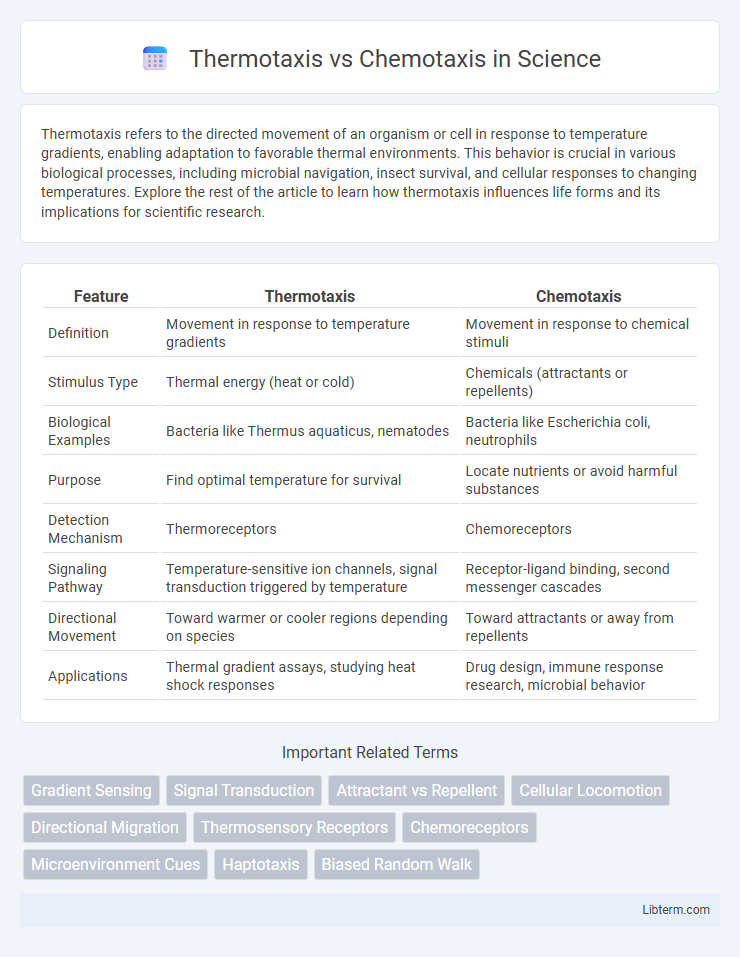Thermotaxis refers to the directed movement of an organism or cell in response to temperature gradients, enabling adaptation to favorable thermal environments. This behavior is crucial in various biological processes, including microbial navigation, insect survival, and cellular responses to changing temperatures. Explore the rest of the article to learn how thermotaxis influences life forms and its implications for scientific research.
Table of Comparison
| Feature | Thermotaxis | Chemotaxis |
|---|---|---|
| Definition | Movement in response to temperature gradients | Movement in response to chemical stimuli |
| Stimulus Type | Thermal energy (heat or cold) | Chemicals (attractants or repellents) |
| Biological Examples | Bacteria like Thermus aquaticus, nematodes | Bacteria like Escherichia coli, neutrophils |
| Purpose | Find optimal temperature for survival | Locate nutrients or avoid harmful substances |
| Detection Mechanism | Thermoreceptors | Chemoreceptors |
| Signaling Pathway | Temperature-sensitive ion channels, signal transduction triggered by temperature | Receptor-ligand binding, second messenger cascades |
| Directional Movement | Toward warmer or cooler regions depending on species | Toward attractants or away from repellents |
| Applications | Thermal gradient assays, studying heat shock responses | Drug design, immune response research, microbial behavior |
Introduction to Taxis in Biological Systems
Taxis in biological systems refers to the directed movement of organisms or cells in response to environmental stimuli, enabling adaptation and survival. Thermotaxis involves movement toward or away from temperature gradients, often crucial for maintaining optimal physiological conditions. Chemotaxis is the chemical cue-driven navigation where cells migrate toward higher concentrations of attractants or away from repellents, fundamental in processes such as immune response and wound healing.
Defining Thermotaxis: Movement Towards Temperature
Thermotaxis is the directed movement of organisms or cells in response to temperature gradients, allowing them to seek optimal thermal environments for survival and function. Unlike chemotaxis, which involves movement toward or away from chemical stimuli, thermotaxis specifically targets temperature variations as the guiding factor. This behavior is crucial in various biological processes, including microbial colonization, embryonic development, and thermoregulation in poikilothermic animals.
Chemotaxis Explained: Navigating Chemical Gradients
Chemotaxis refers to the directed movement of cells or organisms toward or away from specific chemical stimuli by sensing and responding to concentration gradients. This process is crucial in immune response, where leukocytes migrate toward infection sites guided by chemoattractants like cytokines and chemokines. Molecular mechanisms involve receptor binding on the cell surface, signal transduction pathways, and cytoskeletal rearrangement to propel the cell in the chemical gradient's direction.
Cellular Mechanisms Underlying Thermotaxis
Thermotaxis involves cellular mechanisms where temperature gradients are detected by thermosensitive ion channels such as TRP (transient receptor potential) channels, triggering intracellular signaling cascades that direct cell movement. This process differs from chemotaxis, which relies primarily on G-protein-coupled receptors detecting chemical gradients to activate downstream pathways like PI3K and Rac. The ability of thermosensors to modulate calcium influx plays a crucial role in reorienting the cytoskeleton during thermotactic navigation.
Molecular Basis of Chemotaxis
Chemotaxis relies on molecular receptors such as methyl-accepting chemotaxis proteins (MCPs) that detect specific chemical gradients, triggering intracellular signaling cascades involving Che proteins like CheA and CheY to regulate flagellar rotation. This molecular system allows bacteria to move toward attractants or away from repellents by modulating motility in response to ligand binding. In contrast, thermotaxis mechanisms involve temperature-sensitive proteins and channels that detect thermal gradients, but chemotaxis provides a more diverse and finely tuned molecular sensory system for environmental navigation.
Comparative Analysis: Thermotaxis vs Chemotaxis
Thermotaxis and chemotaxis are both cellular movement responses to environmental gradients, with thermotaxis directed by temperature changes and chemotaxis guided by chemical concentration gradients. Thermotaxis primarily involves heat-sensitive receptors and ion channels to detect thermal variations, whereas chemotaxis relies on membrane-bound chemoreceptors and intracellular signaling pathways to sense and respond to specific chemical attractants or repellents. Comparative studies highlight that thermotaxis generally triggers more localized responses within narrow temperature ranges, while chemotaxis allows broader adaptability to complex chemical landscapes, playing critical roles in microbial survival, immune response, and development.
Physiological Roles and Examples in Nature
Thermotaxis guides organisms like nematodes and bacteria to optimal temperatures for survival, playing a crucial role in homeostasis and environmental adaptation. Chemotaxis enables cells such as neutrophils to navigate chemical gradients, essential for immune responses and wound healing. Both mechanisms are vital for locating resources and maintaining physiological balance in diverse ecosystems.
Signaling Pathways Involved in Both Processes
Thermotaxis and chemotaxis involve distinct but sometimes overlapping signaling pathways that enable organisms to navigate environmental gradients. Thermotaxis primarily relies on temperature-sensitive ion channels such as TRP channels, which trigger downstream calcium signaling cascades to regulate cellular responses. Chemotaxis utilizes G-protein-coupled receptors (GPCRs) to detect chemical gradients, activating PI3K and Ras pathways that reorganize the cytoskeleton and direct cell movement toward chemoattractants.
Applications in Medicine and Biotechnology
Thermotaxis enables targeted thermal therapies by guiding cells or microorganisms toward specific temperature gradients, enhancing treatments like hyperthermia for cancer. Chemotaxis plays a crucial role in immune response modulation and wound healing by directing cellular movement toward chemical signals, improving drug delivery and tissue regeneration techniques. Both mechanisms are harnessed in biotechnology for the design of biosensors and microbial fuel cells, optimizing efficiency through temperature or chemical gradient control.
Future Directions in Taxis Research
Future directions in taxis research emphasize developing advanced imaging and computational modeling techniques to unravel the complex signaling pathways underlying thermotaxis and chemotaxis. Emerging studies aim to integrate multi-omics data to identify specific molecular sensors and effectors that mediate temperature and chemical gradient detection. Innovations in synthetic biology propose engineering artificial taxis systems for environmental monitoring and targeted drug delivery applications.
Thermotaxis Infographic

 libterm.com
libterm.com